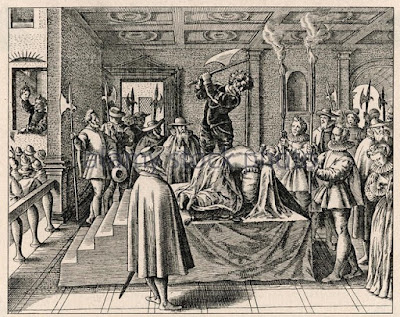At the age of nine in Stirling Castle, Princess Mary was crowned Mary Queen of Scots. The English King Henry VIII, having a desire to conquer Scotland, thought it uncouth to attack a country with such a young queen, so he set plotted to marry her to his son in order to join the two countries under one monarchy. Thus began the unfortunate political career of Mary.
Since Mary, like her fellow country-folk was Catholic, the Scottish court decided it would be better for her to marry into a Catholic family in a Catholic country. Therefore, they arranged for Mary Queen of Scots to wed Francis, a dauphin of France in an attempt to unify the two kingdoms into one country under a Catholic crown. The two children were wed and Queen Mary spent her younger years in the French court, planning to be welcomed home when she came of age.
Meanwhile, Henry VIII was embarking on a campaign of terrorism and intimidation in Scotland. Her husband, the sickly weakling Francis, came down with an ear infection which spread into his brain and caused severe inflammation that led to his death before he grew old enough to ascend to the French throne. Mary returned to Scotland in 1561 and found her country changed. Due to the intimidation of the Scottish people by Henry VIII and his troops, many people had started turning away from the Catholic church and began embracing Protestantism. Mary then wed her cousin Henry Stewart, the Earl of Darnley. Some historians have theorized that he raped her and therefore the marriage was a shotgun wedding. Darnley nevertheless turned out to be a nasty, violent man. In 1567 his house was bombed and he was strangled as he tried to escape. Some Protestant nobles were convinced that Mary had made arrangements with others to assassinate her husband. After she married her third husband, James Hepburn, the Fourth Earl of Bothwell, they sentenced her to prison as an accomplice to conspiracy and murder.
At this time, Mary was still popular with Catholics, many of which wanted her to regain her crown. The English Queen Elizabeth I was considered by them to be an illegitimate bastard queen because Catholics did not believe in divorce and Henry VIII had her with a wife who was not his first. Mary escape from her prison and secretly assembled an army of loyalists who went to war against the Protestant army in a town near Glasgow. The Catholic troops got slaughtered and Mary fled south to England naively expecting Queen Elizabeth I to help her.
Instead, fearing that Mary wished to usurp her and gain the English throne, Elizabeth I imprisoned her again. Although kept captive, Mary lived a life of royal luxury in various castles that would have been the envy of the peasant farmers of her age. After eighteen years of wallowing in self-pity, Mary requested that her son King James VI of Scotland free her so she could reunite with him and rule by his side. James felt nothing but contempt for her and the suspicion that other royals had of her continued to grow.
One day, a young courier named Gilbert Gifford arrived with a bundle of letters from France that had been allegedly sitting idly in the French embassy in London. The letters had not been delivered because supposedly they were afraid of them being intercepted by people hostile to Mary. Gifford claimed to be a Catholic and loyal to the cause of Mary’s re-ascent to the throne. After some discussion, Gifford agreed to act as a go-between for Mary and a group of conspirators in the taverns of London. He agreed to take encrypted messages from Mary to a man named Anthony Babington who planned to overthrow Queen Elizabeth I with the backing of supporters from France and other continental Catholic kingdoms. The messages were to be written in a nomenclatur using a cipher script with codewords. The communications were smuggled in and out of the castle in hidden compartments inside beer barrels.
Gilbert Gifford was, in fact, a spy for Queen Elizabeth. When acting as secret courier between Mary and Babington, he first took the correspondences to the English secret police who would copy the contents and give the originals back to Gifford who then delivered them to their intended recipients. The spies had an expert cryptanalyst on board who successfully decoded the messages by using frequency analysis techniques and thereby proved Mary’s harmful intent.
Mary was taken to trial. She meekly pleaded innocence and then the encrypted letters were admitted as evidence. The judges found her guilt and sentenced her to death. In February 1587, a crowd of 300 gathered in the Great Hall of Fotheringhay Castle and watched as she laid her head on the chopping block and the executioner cut it off with one stroke of the ax. It is said that her lapdog was hiding in her skirts and after the beheading he crawled out, laid between her neck and head and growled as they tried to pull him away.
The authenticity of Mary’s and Babington’s letters is in doubt by some historians and there are those who believe Mary was framed by Queen Elizabeth I.
Singh, Simon. The Code Book: The Science of Secrecy from Ancient Egypt to Quantum Cryptography. Anchor Books, 1999.

No comments:
Post a Comment